Results
-
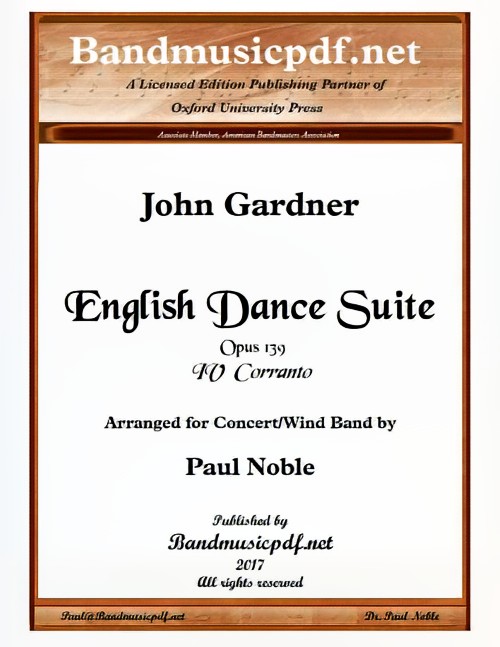 £95.00
£95.00English Dance Suite - IV. Corranto (Concert Band - Score and Parts) - Gardner, John - Noble, Paul
Arranged for the modern Concert/Wind Band, scored for three trumpets, reasonable doubling of parts where the original musical effect is not altered so that players can have a more responsible and enjoyable experience, more legible parts with less doubling on one staff, etc. The piece is offered either as a complete suite of seven movements, and also as seven individual movements which may be purchased independently. The English Dance Suite was originally composed by John Gardner for Wind Band, and has been re-set for the modern Concert Band instrumentation. Both the original version, edited and type-set by Paul Noble, and this arrangement are first editions now available for purchase to bands around the world. The set of seven Renaissance dances depict John Gardner's love of Scottish music, the Renaissance heritage, and some of his own mischievous approach to music. The first movement, Chacony on a Golden Theme, reminiscent of the Allegro movement of Purcell's Golden Sonata, is much used as a vehicle for variation on a repeated short harmonic progression, often involving a fairly short repetitive bass-line which offered a compositional outline for variation, decoration, figuration and melodic invention. In this it closely resembles the passacaglia. The Alman originated in the 16th century as a duple metere dance of moderate tempo, already considered very old, with a characteristic double-knocking upbeat of one or occasionally three sixteenth notes. It appears to have derived from a German dance but no identifiable dance and no German dance instructions from this era survive. The Hornpipe, usually in 3/2 dance rhythm, is an Irish, Scottish and English dance. It is done in hard shoes, which are used to help keep track of how the dancer keeps in time. There are two variations of the hornpipe dance: fast and slow. Usually, more experienced dancers will do the slow hornpipe but younger dancers will start out with the fast hornpipe and then switch in later years. The Corranto is a 16th-century court dance characterized by short advances and retreats, in quick triple time. The Volta (Italian: the turn or turning) is an anglicised name from the later Renaissance. Its main figure consisted of a turn and lift in a sort of closed position. The Pavan is a slow processional dance common in Europe during the 16th century. The Reel, indigenous to Scotland, consists largely of quaver (eighth note) movement with an accent on the first and third beats of the bar.
Estimated dispatch 7-14 working days
-
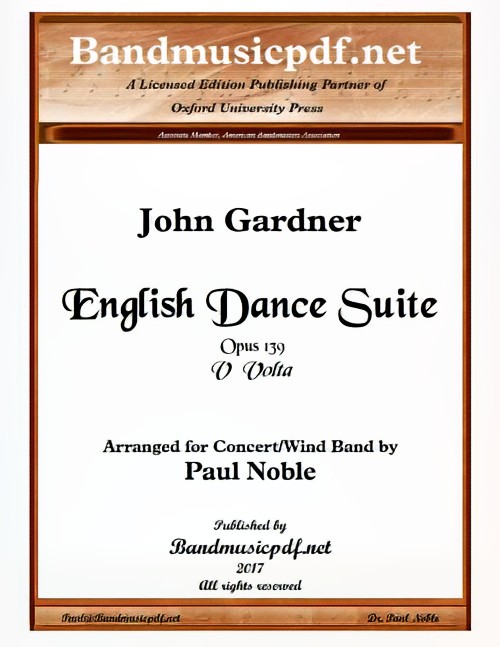 £75.00
£75.00English Dance Suite - V. Volta (Concert Band - Score and Parts) - Gardner, John - Noble, Paul
Arranged for the modern Concert/Wind Band, scored for three trumpets, reasonable doubling of parts where the original musical effect is not altered so that players can have a more responsible and enjoyable experience, more legible parts with less doubling on one staff, etc. The piece is offered either as a complete suite of seven movements, and also as seven individual movements which may be purchased independently. The English Dance Suite was originally composed by John Gardner for Wind Band, and has been re-set for the modern Concert Band instrumentation. Both the original version, edited and type-set by Paul Noble, and this arrangement are first editions now available for purchase to bands around the world. The set of seven Renaissance dances depict John Gardner's love of Scottish music, the Renaissance heritage, and some of his own mischievous approach to music. The first movement, Chacony on a Golden Theme, reminiscent of the Allegro movement of Purcell's Golden Sonata, is much used as a vehicle for variation on a repeated short harmonic progression, often involving a fairly short repetitive bass-line which offered a compositional outline for variation, decoration, figuration and melodic invention. In this it closely resembles the passacaglia. The Alman originated in the 16th century as a duple metere dance of moderate tempo, already considered very old, with a characteristic double-knocking upbeat of one or occasionally three sixteenth notes. It appears to have derived from a German dance but no identifiable dance and no German dance instructions from this era survive. The Hornpipe, usually in 3/2 dance rhythm, is an Irish, Scottish and English dance. It is done in hard shoes, which are used to help keep track of how the dancer keeps in time. There are two variations of the hornpipe dance: fast and slow. Usually, more experienced dancers will do the slow hornpipe but younger dancers will start out with the fast hornpipe and then switch in later years. The Corranto is a 16th-century court dance characterized by short advances and retreats, in quick triple time. The Volta (Italian: the turn or turning) is an anglicised name from the later Renaissance. Its main figure consisted of a turn and lift in a sort of closed position. The Pavan is a slow processional dance common in Europe during the 16th century. The Reel, indigenous to Scotland, consists largely of quaver (eighth note) movement with an accent on the first and third beats of the bar.
Estimated dispatch 7-14 working days
-
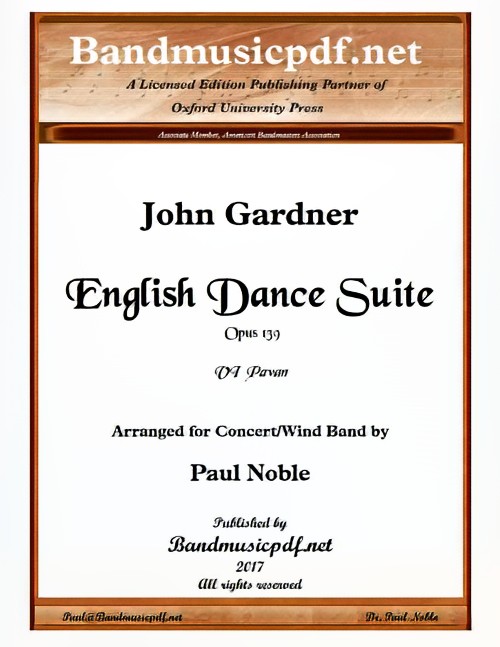 £75.00
£75.00English Dance Suite - VI. Pavan (Concert Band - Score and Parts) - Gardner, John - Noble, Paul
Arranged for the modern Concert/Wind Band, scored for three trumpets, reasonable doubling of parts where the original musical effect is not altered so that players can have a more responsible and enjoyable experience, more legible parts with less doubling on one staff, etc. The piece is offered either as a complete suite of seven movements, and also as seven individual movements which may be purchased independently. The English Dance Suite was originally composed by John Gardner for Wind Band, and has been re-set for the modern Concert Band instrumentation. Both the original version, edited and type-set by Paul Noble, and this arrangement are first editions now available for purchase to bands around the world. The set of seven Renaissance dances depict John Gardner's love of Scottish music, the Renaissance heritage, and some of his own mischievous approach to music. The first movement, Chacony on a Golden Theme, reminiscent of the Allegro movement of Purcell's Golden Sonata, is much used as a vehicle for variation on a repeated short harmonic progression, often involving a fairly short repetitive bass-line which offered a compositional outline for variation, decoration, figuration and melodic invention. In this it closely resembles the passacaglia. The Alman originated in the 16th century as a duple metere dance of moderate tempo, already considered very old, with a characteristic double-knocking upbeat of one or occasionally three sixteenth notes. It appears to have derived from a German dance but no identifiable dance and no German dance instructions from this era survive. The Hornpipe, usually in 3/2 dance rhythm, is an Irish, Scottish and English dance. It is done in hard shoes, which are used to help keep track of how the dancer keeps in time. There are two variations of the hornpipe dance: fast and slow. Usually, more experienced dancers will do the slow hornpipe but younger dancers will start out with the fast hornpipe and then switch in later years. The Corranto is a 16th-century court dance characterized by short advances and retreats, in quick triple time. The Volta (Italian: the turn or turning) is an anglicised name from the later Renaissance. Its main figure consisted of a turn and lift in a sort of closed position. The Pavan is a slow processional dance common in Europe during the 16th century. The Reel, indigenous to Scotland, consists largely of quaver (eighth note) movement with an accent on the first and third beats of the bar.
Estimated dispatch 7-14 working days
-
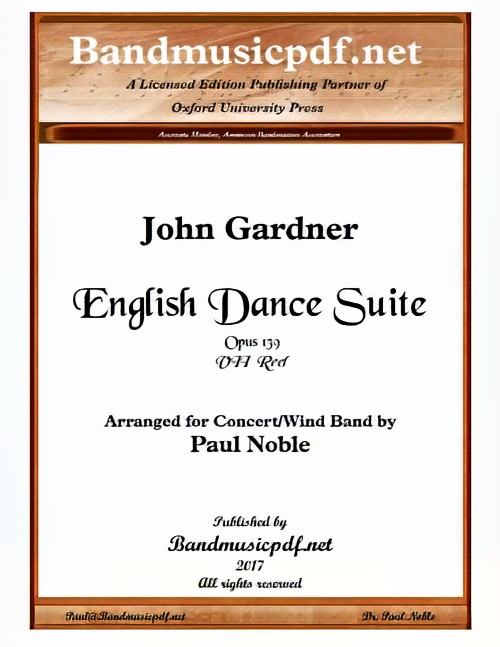 £125.00
£125.00English Dance Suite - VII. Reel (Concert Band - Score and Parts) - Gardner, John - Noble, Paul
Arranged for the modern Concert/Wind Band, scored for three trumpets, reasonable doubling of parts where the original musical effect is not altered so that players can have a more responsible and enjoyable experience, more legible parts with less doubling on one staff, etc. The piece is offered either as a complete suite of seven movements, and also as seven individual movements which may be purchased independently. The English Dance Suite was originally composed by John Gardner for Wind Band, and has been re-set for the modern Concert Band instrumentation. Both the original version, edited and type-set by Paul Noble, and this arrangement are first editions now available for purchase to bands around the world. The set of seven Renaissance dances depict John Gardner's love of Scottish music, the Renaissance heritage, and some of his own mischievous approach to music. The first movement, Chacony on a Golden Theme, reminiscent of the Allegro movement of Purcell's Golden Sonata, is much used as a vehicle for variation on a repeated short harmonic progression, often involving a fairly short repetitive bass-line which offered a compositional outline for variation, decoration, figuration and melodic invention. In this it closely resembles the passacaglia. The Alman originated in the 16th century as a duple metere dance of moderate tempo, already considered very old, with a characteristic double-knocking upbeat of one or occasionally three sixteenth notes. It appears to have derived from a German dance but no identifiable dance and no German dance instructions from this era survive. The Hornpipe, usually in 3/2 dance rhythm, is an Irish, Scottish and English dance. It is done in hard shoes, which are used to help keep track of how the dancer keeps in time. There are two variations of the hornpipe dance: fast and slow. Usually, more experienced dancers will do the slow hornpipe but younger dancers will start out with the fast hornpipe and then switch in later years. The Corranto is a 16th-century court dance characterized by short advances and retreats, in quick triple time. The Volta (Italian: the turn or turning) is an anglicised name from the later Renaissance. Its main figure consisted of a turn and lift in a sort of closed position. The Pavan is a slow processional dance common in Europe during the 16th century. The Reel, indigenous to Scotland, consists largely of quaver (eighth note) movement with an accent on the first and third beats of the bar.
Estimated dispatch 7-14 working days
-
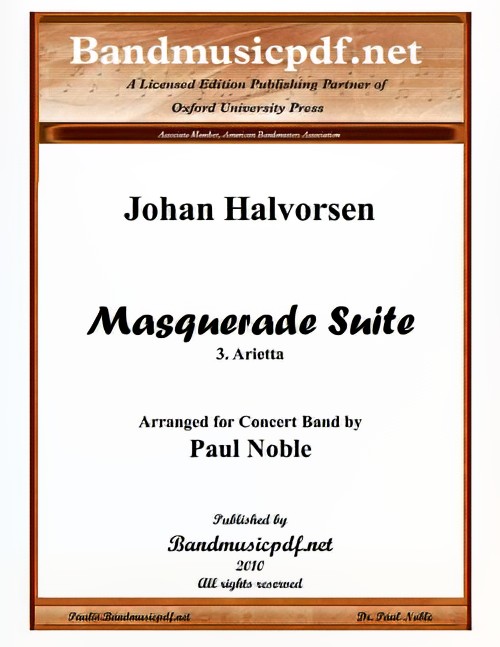 £75.00
£75.00Arietta (from Masquerade Suite) (Concert Band - Score and Parts) - Halvorsen, Johan - Noble, Paul
Masquerade Suite was composed by Johan Halvorsen, one of the best-kept secrets of Norway. Not only was he an accomplished violinist and conductor, but also he was among the most prominent Norwegian composers in the generation following Edvard Grieg. His compositions develop the national Romantic tradition of his friends Grieg and Svendsen, but his was a distinctive style marked by brilliant orchestration inspired by the French Romantic composers. The original version of Masquerade Suite had nine movements. Paul Noble has selected five of the most suitable movements for band transcription and grouped them into this beautiful suite. The U.S. Navy Band in Washington, D.C. gave the premiere performance of this work. The first movement, Holberg Overture, sets the mood, pace, and musical themes for the entire suite, with rousing opening themes, followed by a grand fugue in the development section. This is clearly a piece for accomplished bands, giving all wind players a real workout. Each of the succeeding movements has a distinctive style, making the suite a significant addition to the repertoire of the Concert Band. Especially noteworthy is the Arietta, the easiest of the movements, and can easily stand alone with its haunting flute and oboe melodies and dramatic crescendo, the crisp solos in the Molinasque, and the final movement, which is very much like a circus march, fast, lively and short!
Estimated dispatch 7-14 working days
-
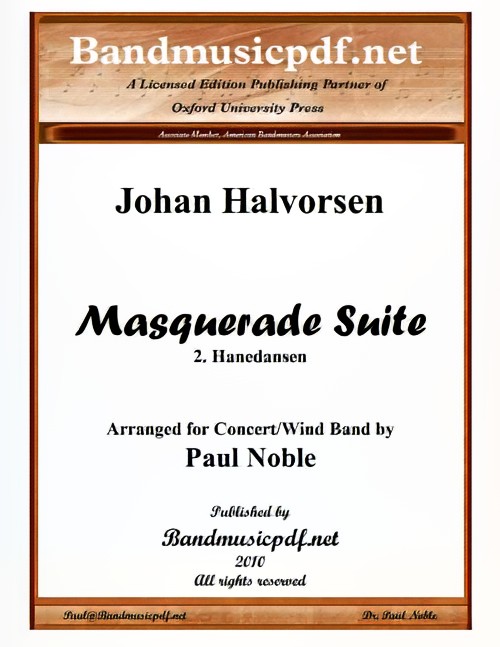 £75.00
£75.00Hanedansen (from Masquerade Suite) (Concert Band - Score and Parts) - Halvorsen, Johan - Noble, Paul
Masquerade Suite was composed by Johan Halvorsen, one of the best-kept secrets of Norway. Not only was he an accomplished violinist and conductor, but also he was among the most prominent Norwegian composers in the generation following Edvard Grieg. His compositions develop the national Romantic tradition of his friends Grieg and Svendsen, but his was a distinctive style marked by brilliant orchestration inspired by the French Romantic composers. The original version of Masquerade Suite had nine movements. Paul Noble has selected five of the most suitable movements for band transcription and grouped them into this beautiful suite. The U.S. Navy Band in Washington, D.C. gave the premiere performance of this work. The first movement, Holberg Overture, sets the mood, pace, and musical themes for the entire suite, with rousing opening themes, followed by a grand fugue in the development section. This is clearly a piece for accomplished bands, giving all wind players a real workout. Each of the succeeding movements has a distinctive style, making the suite a significant addition to the repertoire of the Concert Band. Especially noteworthy is the Arietta, the easiest of the movements, and can easily stand alone with its haunting flute and oboe melodies and dramatic crescendo, the crisp solos in the Molinasque, and the final movement, which is very much like a circus march, fast, lively and short!
Estimated dispatch 7-14 working days
-
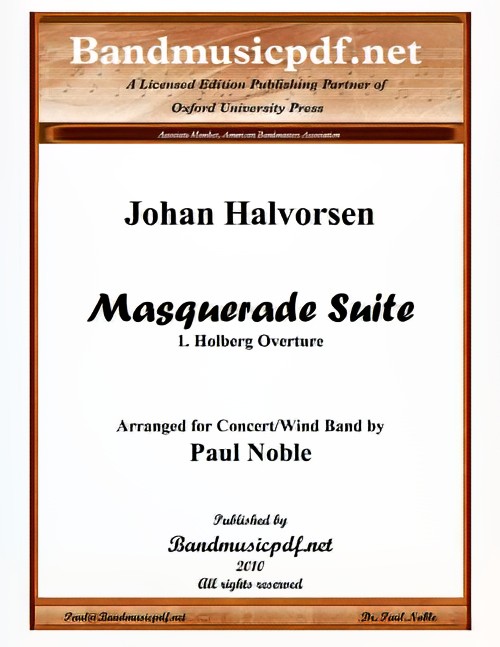 £75.00
£75.00Holberg Overture (from Masquerade Suite) (Concert Band - Score and Parts) - Halvorsen, Johan - Noble, Paul
Masquerade Suite was composed by Johan Halvorsen, one of the best-kept secrets of Norway. Not only was he an accomplished violinist and conductor, but also he was among the most prominent Norwegian composers in the generation following Edvard Grieg. His compositions develop the national Romantic tradition of his friends Grieg and Svendsen, but his was a distinctive style marked by brilliant orchestration inspired by the French Romantic composers. The original version of Masquerade Suite had nine movements. Paul Noble has selected five of the most suitable movements for band transcription and grouped them into this beautiful suite. The U.S. Navy Band in Washington, D.C. gave the premiere performance of this work. The first movement, Holberg Overture, sets the mood, pace, and musical themes for the entire suite, with rousing opening themes, followed by a grand fugue in the development section. This is clearly a piece for accomplished bands, giving all wind players a real workout. Each of the succeeding movements has a distinctive style, making the suite a significant addition to the repertoire of the Concert Band. Especially noteworthy is the Arietta, the easiest of the movements, and can easily stand alone with its haunting flute and oboe melodies and dramatic crescendo, the crisp solos in the Molinasque, and the final movement, which is very much like a circus march, fast, lively and short!
Estimated dispatch 7-14 working days
-
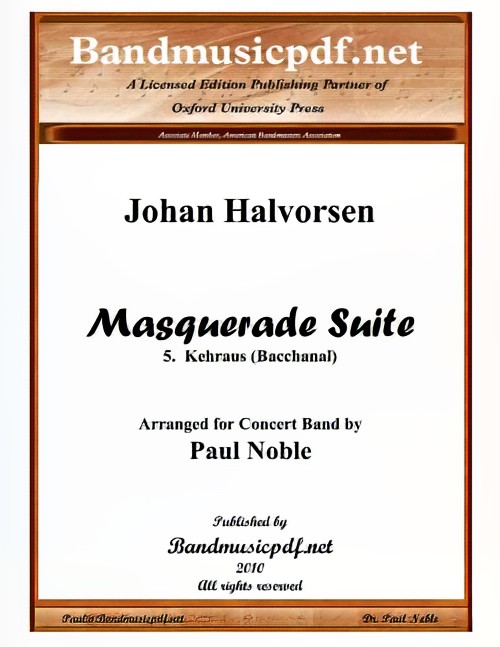 £65.00
£65.00Kehraus (from Masquerade Suite) (Concert Band - Score and Parts) - Halvorsen, Johan - Noble, Paul
Masquerade Suite was composed by Johan Halvorsen, one of the best-kept secrets of Norway. Not only was he an accomplished violinist and conductor, but also he was among the most prominent Norwegian composers in the generation following Edvard Grieg. His compositions develop the national Romantic tradition of his friends Grieg and Svendsen, but his was a distinctive style marked by brilliant orchestration inspired by the French Romantic composers. The original version of Masquerade Suite had nine movements. Paul Noble has selected five of the most suitable movements for band transcription and grouped them into this beautiful suite. The U.S. Navy Band in Washington, D.C. gave the premiere performance of this work. The first movement, Holberg Overture, sets the mood, pace, and musical themes for the entire suite, with rousing opening themes, followed by a grand fugue in the development section. This is clearly a piece for accomplished bands, giving all wind players a real workout. Each of the succeeding movements has a distinctive style, making the suite a significant addition to the repertoire of the Concert Band. Especially noteworthy is the Arietta, the easiest of the movements, and can easily stand alone with its haunting flute and oboe melodies and dramatic crescendo, the crisp solos in the Molinasque, and the final movement, which is very much like a circus march, fast, lively and short!
Estimated dispatch 7-14 working days
-
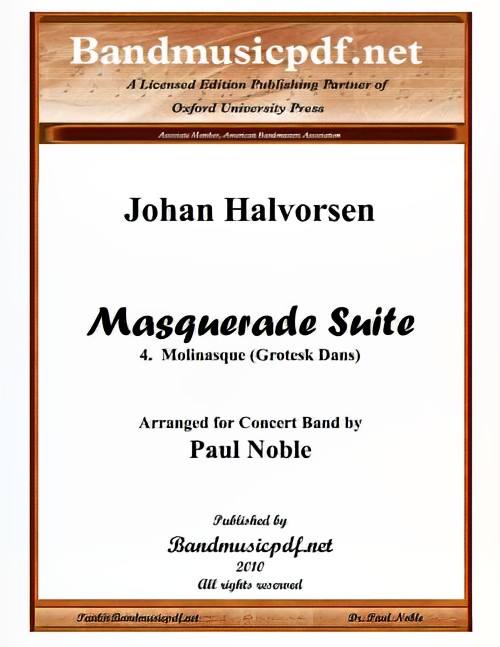 £75.00
£75.00Molinasque (from Masquerade Suite) (Concert Band - Score and Parts) - Halvorsen, Johan - Noble, Paul
Masquerade Suite was composed by Johan Halvorsen, one of the best-kept secrets of Norway. Not only was he an accomplished violinist and conductor, but also he was among the most prominent Norwegian composers in the generation following Edvard Grieg. His compositions develop the national Romantic tradition of his friends Grieg and Svendsen, but his was a distinctive style marked by brilliant orchestration inspired by the French Romantic composers. The original version of Masquerade Suite had nine movements. Paul Noble has selected five of the most suitable movements for band transcription and grouped them into this beautiful suite. The U.S. Navy Band in Washington, D.C. gave the premiere performance of this work. The first movement, Holberg Overture, sets the mood, pace, and musical themes for the entire suite, with rousing opening themes, followed by a grand fugue in the development section. This is clearly a piece for accomplished bands, giving all wind players a real workout. Each of the succeeding movements has a distinctive style, making the suite a significant addition to the repertoire of the Concert Band. Especially noteworthy is the Arietta, the easiest of the movements, and can easily stand alone with its haunting flute and oboe melodies and dramatic crescendo, the crisp solos in the Molinasque, and the final movement, which is very much like a circus march, fast, lively and short!
Estimated dispatch 7-14 working days
-
£102.99
Jazz Suite No. 2 - March - Dimitri Shostakovich
In 1938 Shostakovich composed his Second Jazz Suite at the request of the recently founded State Orchestra for Jazz conducted by Victor Knushevitsky. This suite was originally scored for a complete symphony orchestra to which four saxophones, an accordion and a guitar had been added. The Jazz Suite no. 1 in three movements, composed in 1934, had been written for a smaller ensemble. The title 'Jazz Suite' is rather misleading, as the composer definitely uses the style of light music. Back in 1928, the twenty-two-year-old Shostakovich had already composed some light music. A bet among friends to make an orchestration of the popular song 'Tea for Two' in less then one hour time, causedhim to compose 'Tahiti Trot'. Shostakovich easily won the bet as he completed the original and witty arrangement within only forty minutes!
Estimated dispatch 7-14 working days
